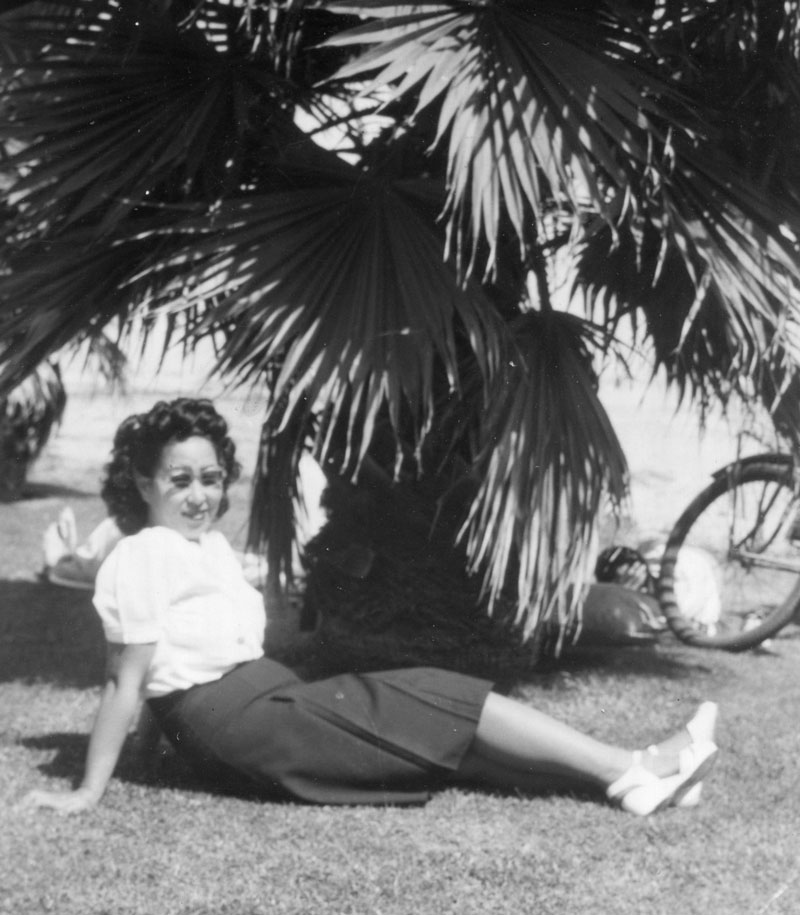Exhibit: Santa Barbara Asian American & Pacific Islander Heritage, 1870s-1970s
Manabu Kuroda (1911-1972)
Dedicated Church Member
By Holly Snyder

Manabu (Frank) Kuroda
Manabu Frank Kuroda was born in Kumamoto Ken, Japan on June 25, 1911, to parents Tameji and Takeju Magata Kuroda. He was the youngest of four children. Manabu’s oldest brother, Mahiko Kuroda, came first to the United States in 1928 heading to Mexicali, Mexico where a friend lived. According to a passenger list, Manabu arrived in San Francisco two years later, with the intent to go to Mexico where his brother was living. He traveled with a man from Brazil with the last name Oshima and traveled back to California. He ended up taking the Oshima name until the 1950s. Manabu’s brother Seiichi worked as a steward on passenger ships and traveled to many ports in the United States. They had one sister who remained in Japan.
Manabu first settled in San Luis Obispo County and then Guadalupe and became a foreman at a ranch in the 1930s. He had several jobs including landscaping and watchmaking.

Tameji and Takeju Magata Kuroda

Grace Kuwamoto Kuroda
Gila River
Manabu was sent to Gila River internment camp where he met and married Grace Kuwamoto.
Matsuko Grace Kuwamoto was born on January 4, 1919 in Santa Barbara to parents Sanzo and Matsuyo Matsunaga Kuwamoto, both from Japan. Sanzo Kuwamoto was born in 1885 and came to San Francisco through Hawaii in 1903. Matsuyo was born in 1898 and later joined her husband in Santa Barbara shortly after arriving in San Francisco in 1918. Sanzo and Matsuyo had five children—Matsuko Grace, Mitsuye Mitzi, Kimiko Alice, Buichi Frank, and Mieko Mary Kuwamoto.
Due to filling out the Loyalty Questionnaire with “No,” “No” answers Manabu and Grace were sent to Tule Lake. The Kuwamotos stayed in Gila River from 1942-1945.

Gary, Shuji, and Kenny in front of store
In Tule Lake, Manabu and Grace’s first son, Koichi Gary Oshima, was born. When they were released from Tule Lake, they returned to Santa Barbara where they had three more sons—Kenneth, Shuji Francis (Frank), and Norio Allen.
Santa Barbara
Immediately upon arriving back in Santa Barbara, Manabu, Grace, and their son Gary lived at the Buddhist Church of Santa Barbara when it was on Canon Perdido and Santa Barbara Streets. During this time, he also established his landscaping business. Sometimes he would take his children with him to work; however, he found it was better if they did not accompany him after all.
In 1947, he built their house at 629 Haley Street where Ooty’s Scooters store is now located. He built a Japanese convenience store initially named Tecolote in the front and lived in the back. They later changed the name of the store to Oshimas. Manabu added a second story to his home, and they lived there until the late 1960s-early 1970s. Grace ran the store that sold a variety of Japanese items such as food, notebooks, dolls, and other everyday items. Their son Gary remembers having to carry 50 to 100-pound bags of rice to cars throughout high school.
Manabu decided to change his and his family’s last name back to Kuroda around 1962. The children always identified themselves as Oshimas and it took a bit of time to get used to their “new” name.
Buddhist Church
Manabu was an active member in the Buddhist Church of Santa Barbara. He was the church’s president from 1965-1967 when the new church on Montecito Street was built. He also purchased two homes near the new church site on Montecito Street.

Gary, Shuji, and Kenny in front of their house on Haley Street, next door to Joe's Café and across the street from U.S. Market, c. 1950
Community and Family Life
Manabu was also an active member of Santa Barbara Gardeners Association and was their treasurer between 1969-1970.
He also had an artistic side. He enjoyed doing calligraphy and pottery, as well as playing the violin. Grace enjoyed needlepoint, Bunka Shishu (Japanese punch embroidery and thread painting), and knitting.
The family often took trips to Disneyland and other California locations, places close enough to get away but return due to work. They also visited the Sumida family home in Summerland often to purchase their traditional Japanese food.
Manabu and Grace divorced in the late 1960s. Manabu met Reverend Seiko Okahashi at the Buddhist Church and got married in Kyoto, Japan in 1970. However, they were only together for a short time as he passed away on January 29, 1972, in Santa Barbara at the age of 60. He is remembered as a reserved man, yet hardworking and dedicated to his church.
Grace was later married to Tadao Kanetomo for 25 years until his death in 2001. Grace loved to laugh and talk with friends and family, do needlework, and visit Las Vegas. Grace passed away on August 15, 2005, in Santa Barbara at the age of 86.
Acknowledgements
Gary Kuroda, son of Manabu Kuroda and Grace (Kuwamoto) Kuroda Kanetomo
Grace Kanetomo, Obituary 16E-335, Santa Barbara County Genealogical Society (https://sbgen.org/start-your-search/search-database/#/search/); citing Obituary Scrapbooks, held by the Santa Barbara Historical Museum, Gledhill Library.
Manabu Frank Kuroda, Obituary 16-297, Santa Barbara County Genealogical Society (https://sbgen.org/start-your-search/search-database/#/search/); citing Obituary Scrapbooks, held by the Santa Barbara Historical Museum, Gledhill Library.
Manabu Frank Kuroda, Mortuary Record, 29-Jan-1972 Santa Barbara County Genealogical Society (https://sbgen.org/start-your-research); citing Welch-Ryce-Haider Mortuary books.
